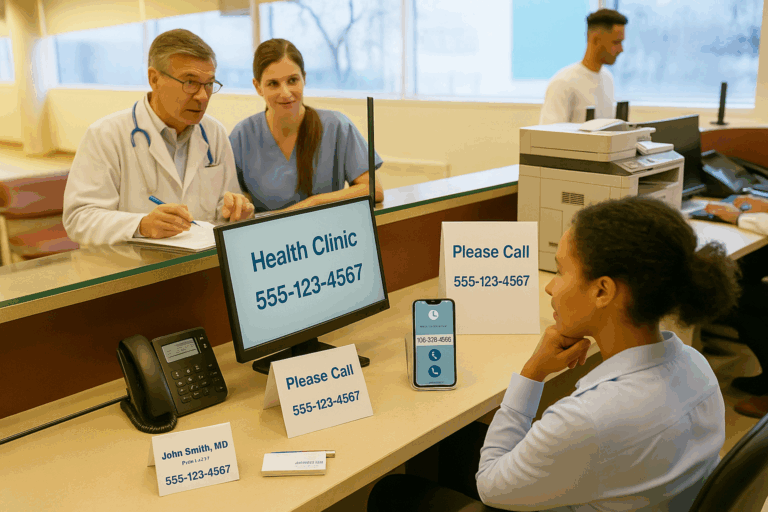Baseball, football, hockey, soccer, tennis — and the newest sports craze, pickleball — all center on competition. Physician practices also compete, vying not just for patients but for excellence in patient care and service efficiency.
If you are a physician or medical practice administrator, you already know this. However, knowing it and putting it into action are two different things. That’s why marketing your practice is so critical.
Marketing goes beyond direct mail, an online presence, and advertisements. Not only should it help you attract and retain patients, but it should also aid your practice in increasing reimbursement while cutting costs. That’s not always easy to do, especially with increasing overhead.
To ensure your practice remains competitive, it is essential to focus on communication, patient outreach and data-driven analytics. Along with those focus areas, consider verifying that your practice is listed correctly in insurers’ directory lists — and ask the payer to make corrections if necessary — monitor your online ratings and reviews and respond to those comments, whether positive or negative.
Your practice doesn’t have to be large to achieve these marketing goals. In a survey of patients who reported that they prefer independently-owned medical practices, roughly 80 percent appreciated the more personal relationship with their provider, 57 percent said the quality of care was higher, and 60 percent trusted these providers more.
Secure Communication
Research has identified multiple ways HIPAA-compliant communication can lead to better health outcomes, from reducing medication errors and hospital readmissions to increasing patient satisfaction with provider visits. There’s also evidence that indicates that there are strong positive relationships between a healthcare team member’s communication skills and a patient’s capacity to follow through with medical recommendations, self-manage a chronic medical condition and adopt preventive health behaviors.
A good place to start modernizing your practice is where most patients start the process of care — your front office. It’s typically where patients experience their first impression and can make or break their loyalty to you.
Even when patient calls are answered promptly, quickly getting them routed to the appropriate practice staff member can make a big difference in their experience with your practice. They do not want to have to explain their request to multiple people.
Not all patients want to call their provider, though. More than 95 percent of patients prefer texting for healthcare communication. Understanding patient preferences is necessary for engaging patients.
Many small and mid-size provider organizations don’t realize they are missing out on potential new patients because they don’t respond to texts. That’s why your practice, if it doesn’t already, should use a telecommunications platform that can easily and securely manage texting.
Investing in technology to optimize provider-patient communication can be affordable. Upgrading to a modern telecommunication platform lets you give your patients a positive first impression while reducing the administrative burden on you and your staff.
Effective communication in healthcare has many more advantages, including improved staff teamwork and collaboration, fewer patient complaints—resulting in higher patient satisfaction—reduced cost of care, and decreased stress and burnout for clinicians.
Personalized Patient Outreach
The healthcare consumerism trend is here to stay, and patients expect the sort of personalized experience they have in other industries (i.e., banking, retail) from their providers. Automated outreach enables you to communicate with your patients through targeted and personalized campaigns without additional staff involvement. You can send tailored appointment reminders, marketing messages, and pre-visit or pre-procedure instructions. Messaging can also be customized for patient populations meeting specific criteria, such as age, risk factors, location, last visit date and more.
For practice staff, having access to automated outreach solutions on the front end can result in decreased patient wait times, fewer medical errors and increased satisfaction, all of which positively affect a practice’s revenue cycle. Along with saving time for a provider’s staff, automated text messaging and outreach improve productivity, appointment confirmation rates and patient engagement. It reduces call volume, increases appointment attendance and makes rescheduling appointments easier.
Appointment reminders allow patients to confirm whether the date and time fit their schedule. When prompted by the reminder, they can reschedule their appointment if necessary. This lets provider staff fill the open slot with another patient who is waiting to get into the office sooner, resulting in more satisfied patients.
Patient outreach helps decrease patient no-shows, which consume an average of 14 percent of a practice’s daily revenue. A single no-show can increase attrition by 70 percent.
Patients’ missed appointments due to no-shows and cancellations do more than lead to a loss of anticipated revenue. They often lead to longer wait times for other patients, lower patient satisfaction, wasted resources, reduced productivity and clinical effectiveness, added stress on practice staff, and an overall decrease in the quality of patient care.
When utilizing text messaging to conduct patient outreach, remember that too many text messages can do more harm than good. We recommend you send at most three about an upcoming appointment. Many providers using automated text messaging send out the first message a week before the appointment, then three days prior, followed by 24 hours until the scheduled visit. Avoid texting patients too early or late in the day.
If your patient confirms his or her appointment after the first message, only the reminder text the day before the appointment is necessary. Measure your patients’ engagement regularly, and consider altering the cadence of your appointment reminder texts as it dictates.
Data-Driven Analytics
Physician practices are inundated with data more than ever before, enabling them to gain actionable insight to improve the quality of care, measure KPIs, reduce operational costs, measure and track performance and increase patient safety. By integrating data-driven analytics, they can forecast patient flow and staffing needs, optimize existing clinical staff and improve staffing coverage, again improving patient satisfaction.
Employing custom analytics to inform business decisions allows practices to enjoy almost real-time insight, view and track patient visits, measure health outcomes, manage appropriate access to private health information, analyze performance data and support quick problem-solving. It allows them to transform data into actionable insights to find and reduce inefficiencies, make better-informed clinical decisions and improve financial and clinical performance, all without sacrificing quality of care.
Ensure Reliable Patient Communication and Outreach with RingRx
The RingRx HIPAA-compliant phone system helps hospitals, private practices and medical groups build communications systems that fit their unique needs. We’ll help you create a dependable, modern communications platform to optimize your workflow. Schedule a demo with RingRx to see how we can help your practice build specialized communication applications using our features, capabilities and data to fit your business needs.




